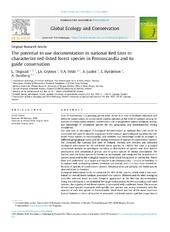| dc.contributor.author | Tingstad, Lise | |
| dc.contributor.author | Grytnes, John-Arvid | |
| dc.contributor.author | Felde, Vivian Astrup | |
| dc.contributor.author | Juslén, Aino | |
| dc.contributor.author | Hyvärinen, Esko | |
| dc.contributor.author | Dahlberg, Anders | |
| dc.date.accessioned | 2019-04-12T13:12:33Z | |
| dc.date.available | 2019-04-12T13:12:33Z | |
| dc.date.issued | 2018-07 | |
| dc.Published | Tingstad L, Grytnes J, Felde VA, Juslén, Hyvärinen, Dahlberg A. The potential to use documentation in national Red Lists to characterize red-listed forest species in Fennoscandia and to guide conservation. Global Ecology and Conservation. 2018;15:e00410 | eng |
| dc.identifier.issn | 2351-9894 | en_US |
| dc.identifier.uri | http://hdl.handle.net/1956/19328 | |
| dc.description.abstract | Loss of biodiversity is a pressing global issue, hence it is vital to facilitate informed and effective conservation. As conservation mainly operates at the level of habitats, aiming for species of conservation interest, conservation and management require adequate ecological knowledge of prioritized species for the geographic and environmental setting considered. Our aim was to investigate if ecological documentation in national Red Lists could be combined and used to identify important forest habitats and ecological variables for red-listed forest species in Fennoscandia, and whether this knowledge could be arranged at different geographical scales and for various selections of species of conservation interest. We compiled the national Red Lists of Finland, Norway and Sweden and extracted ecological information for all red-listed forest species (n = 4830). We used a principal component analysis to investigate variation in distribution of species and their habitat associations and taxonomical groups, and to group species of similar associations. We further used the listed species in Sweden as an example, and compared the proportions of species associated to the ecological variables dead wood, living trees or merely the “forest floor and understory” a) at larger and smaller scale (Fennoscandia – county in Sweden), b) in regions with contrasting biomes (nemoral and boreal), and c) in two more limited selections of species of conservation interest; Fennoscandian and globally red-listed species also red-listed in Sweden. Ecological information could be extracted for 96% of the species, albeit with a low resolution; i.e. overall forest habitats, associated tree species, lifeforms and six other ecological variables selected based on their frequent appearance in the Red List documentation. Using this information, we identified five large-scale patterns for Fennoscandian red-listed species; the majority of red-listed species is associated with coniferous forest. The number of red-listed species associated with specific tree species was poorly correlated with the amount of each tree species in Fennoscandia. Dead wood was one of the most important habitat features in terms of number of associated red-listed species, and the proportion of species associated to dead wood was similar in coniferous, boreal and nemoral broadleaved forests types. We demonstrate that ecological documentation in national Red Lists can be used to identify general ecological variables at varying geographical scales and for different selections of species, albeit not with sufficient resolution to provide detailed local conservation guidelines. | en_US |
| dc.language.iso | eng | eng |
| dc.publisher | Elsevier | en_US |
| dc.rights | Attribution CC BY | eng |
| dc.rights.uri | http://creativecommons.org/licenses/by/4.0/ | eng |
| dc.title | The potential to use documentation in national Red Lists to characterize red-listed forest species in Fennoscandia and to guide conservation | en_US |
| dc.type | Peer reviewed | |
| dc.type | Journal article | |
| dc.date.updated | 2018-09-14T09:16:58Z | |
| dc.description.version | publishedVersion | en_US |
| dc.rights.holder | Copyright 2018 The Author(s) | en_US |
| dc.identifier.doi | https://doi.org/10.1016/j.gecco.2018.e00410 | |
| dc.identifier.cristin | 1605240 | |
| dc.source.journal | Global Ecology and Conservation | |

